From Wikipedia, the free encyclopedia
| OV-10 Bronco | |
|---|---|
 |
|
| A U.S. Air Force OV-10 firing a white phosphorus smoke rocket to mark a ground target | |
| Role | Light attack and observation aircraft |
| Manufacturer | North American Rockwell |
| First flight | 16 July 1965 |
| Introduction | October 1969 |
| Retired | USA (1995) |
| Status | In limited service |
| Primary users | United States Marine Corps (historical) United States Air Force (historical) United States Navy (historical) Royal Thai Air Force (historical) |
| Produced | 1965–86 |
| Number built | 360 |
Contents
Development
Background
The aircraft was initially conceived in the early 1960s through an informal collaboration between WH Beckett and Colonel KP Rice, U.S. Marine Corps, who met at Naval Air Weapons Station China Lake, California, and who also happened to live near each other. The original concept was for a rugged, simple, close air support aircraft integrated with forward ground operations. At the time, the U.S. Army was still experimenting with armed helicopters, and the U.S. Air Force was not interested in close air support.The concept aircraft was to operate from expedient forward air bases using roads as runways. Speed was to be from very slow to medium subsonic, with much longer loiter times than a pure jet. Efficient turboprop engines would give better performance than piston engines. Weapons were to be mounted on the centerline to get efficient unranged aiming like the Lockheed P-38 Lightning and North American F-86 Sabre aircraft. The inventors' favored strafing weapons were self-loading recoilless rifles, which could deliver aimed explosive shells with less recoil than cannons, and a lower per-round weight than rockets. The airframe was to be designed to avoid the back blast.
Beckett and Rice developed a basic platform meeting these requirements, then attempted to build a fiberglass prototype in a garage. The effort produced enthusiastic supporters and an informal pamphlet describing the concept. WH Beckett, who had retired from the Marine Corps, went to work at North American Aviation to sell the aircraft.
Rice states:
The military definition of STOL (500 ft to a 50 ft obstacle) allows takeoff and landing in most of the areas in which limited war might be fought. In addition, the airplane was designed to use roads so that operation would even be possible in jungle areas where clearings are few and far between. As a result the wingspan was to be limited to twenty feet and a heavy trailing arm type landing gear with a tread of 6.5 ft was provided for operation from roads. Float operation was to be feasible...[1]
...it is quite feasible to design the various components so that it can be disassembled easily and stored in a box that would fit in a 6×6 truck bed together with the equipment needed for re-assembly in the field. It could thus be transported by amphibious shipping and either heli-lifted or driven ashore by a 6x6 truck.[2]
Light Armed Reconnaissance Aircraft
A "tri-service" specification for the Light Armed Reconnaissance Aircraft (LARA) was approved by the U.S. Navy, Air Force and Army and was issued in late 1963. The LARA requirement was based on a perceived need for a new type of "jungle fighting" versatile light attack and observation aircraft. Existing military aircraft in the observation role, such as the Cessna O-1 Bird Dog and Cessna O-2 Skymaster, were perceived as obsolescent, with too slow a speed and too small a load capacity for this flexible role.The specification called for a twin-engine, two-man aircraft that could carry at least 2,400 pounds (1,100 kg) of cargo, six paratroopers or stretchers, and be stressed for +8 and -3 gs (basic aerobatic ability). It also had to be able to operate from an aircraft carrier, fly at least 350 miles per hour (560 km/h), take off in 800 feet (240 m) and convert to an amphibian. Various armament had to be carried, including four 7.62 mm (0.300 in) machine guns with 2,000 rounds, and external weapons including a 20 mm (0.79 in) gun pod and AIM-9 Sidewinder air-to-air missiles.
Eleven proposals were submitted, nine of them were: the Grumman Model 134R tandem-seat version of the already fielded U.S. Army's OV-1 Mohawk (the U.S. Marine Corps dropped out of the Mohawk program in 1958), Goodyear GA 39, Beechcraft PD-183, Douglas D-855, Convair Model 48 Charger, Helio 1320, Lockheed CL-760, a Martin design, and the North American/Rockwell NA-300.
In August 1964, the NA-300 was selected. A contract for seven prototype aircraft was issued in October 1964. Convair protested the decision and built a small-wing prototype of the Model 48 Charger anyway, which first flew on 29 November 1964. This was also a twin-boom aircraft that had a broadly similar layout to the OV-10. The Charger, while capable of outperforming the OV-10 in some respects, crashed on 19 October 1965 after 196 test flights. Convair subsequently dropped out of contention.
The Bronco started flying midway through the Charger's test program on 16 July 1965, and became one of the premier counter-insurgency (COIN) aircraft of the next 30 years. It failed to live up to Rice's L2 VMA concept because the DoD insisted on 40-foot (12 m) long wings which made it depend on airbases. Rice concludes:
"The original concept of a small, simple aircraft that could operate close to the supported troops had been almost completely eviscerated by the 'system.' The ability to operate from roads (20 ft span and 6.5 tread) had been ignored, and performance compromised by the short 30 ft span, the extra 1,000 lb for the rough field landing gear and another 1,000 lb of electronics. The 'light, simple' airplane also had a full complement of instruments, ejection seats and seven external store stations. The concept of using ground ordnance and a bomb bay had been ignored, although it did have provisions for four M60 [medium] machine guns. In spite of this growth (almost double the size and weight of our home built), the YOV-10 still had great potential. It would not achieve the advantages of integration with the ground scheme of maneuver, but it did have capabilities at the low end of the performance envelope that were still valuable and unique."[3]The Bronco performed observation, forward air control, helicopter escort, armed reconnaissance, utility light air transport and limited ground attack. The Bronco has also performed aerial radiological reconnaissance, tactical air observation, artillery and naval gunfire spotting, airborne control of tactical air support operations and front line, low-level aerial photography. A prototype in Vietnam designed to lay smoke was extremely successful, kept in service by evaluators for several months, and only reluctantly released, was not purchased due to a perceived lack of mission.[citation needed]
Possible modernized variant
Main article: Light Attack/Armed Reconnaissance
Boeing has recently put together plans internally to build a modernized, improved version of the Bronco, called the OV-10X,[4] to satisfy a possible Air Force requirement for a light attack plane.[5] According to Pentagon
and industry officials, while the aircraft would maintain much of its
1960s-vintage rugged external design, the 21st century modernizations
would include a computerized glass cockpit, intelligence sensors and smart-bomb-dropping
capabilities. Boeing indicates that international interest in
restarting production is growing, to compete with other light attack
aircraft such as the T-6B Texan II, A-67 Dragon and EMB 314 Super Tucano.On 3 February 2010, during the Singapore Air Show, Boeing announced that the international interest for the aircraft was such that it would go on with its development even in the case it failed to win the USAF tender for 100 Light Attack/Armed Reconnaissance aircraft.[6]
Design
The aircraft's design supports effective operations from forward bases. The OV-10 can perform short takeoffs and landings, including on aircraft carriers and large deck amphibious assault ships[7] without using catapults or arresting wires. Further, the OV-10 was designed to takeoff and land on unimproved sites. Repairs can be made with ordinary tools. No ground equipment is required to start the engines. And, if necessary, the engines will operate on high-octane automobile fuel with only a slight loss of power.[8]
The aircraft has responsive handling and can fly for 5 1/2 hours with external fuel tanks.[9] The cockpit has extremely good visibility for a tandem pilot and co-pilot, provided by a wrap-around "greenhouse" that is wider than the fuselage. With the second seat removed, it can carry 3,200 pounds (1,500 kg) of cargo, five paratroopers or two litter patients and an attendant. Empty weight is 6,969 pounds (3,161 kg). Normal operating fueled weight with two crew is 9,908 pounds (4,494 kg). Maximum takeoff weight is 14,446 pounds (6,553 kg).
The bottom of the fuselage contains sponsons or "stub wings" that improve flight performance by decreasing aerodynamic drag underneath the fuselage. The sponsons were mounted horizontally on the prototype. Testing caused them to be redesigned for production aircraft. The downward angle assured that stores carried on the sponsons jettisoned cleanly. Normally four .308 in (7.62 mm) M60C machine guns were carried on the sponsons with the M60Cs accessed through a large forward-opening hatch on the top of each sponson. The sponsons also had four racks to carry bombs, pods or fuel. The wings outboard of the engines contain two additional racks, one per side.
Racked armament in the Vietnam War was usually seven-shot 2.75 in (70 mm) rocket pods with white phosphorus marker rounds or high-explosive rockets, or 5 in (127 mm) four-shot Zuni rocket pods. Bombs, ADSIDS air-delivered/para-dropped unattended seismic sensors, Mk-6 battlefield illumination flares, and other stores were carried as well.[citation needed]
Operational experience showed that there were some weaknesses in the OV-10's design. It is seriously underpowered. This contributed to crashes in Vietnam in sloping terrain because the pilots could not climb fast enough.[9] While specifications state that the aircraft could reach 26,000 feet (7,900 m), in Vietnam the aircraft could reach only 18,000 feet (5,500 m). Also, no OV-10 pilot survived ditching the aircraft.[8]
Operational history
The OV-10 served in the U.S. Air Force, U.S. Marine Corps, and U.S. Navy, as well as in the service of a number of other countries. A total of 81 OV-10 Broncos were ultimately lost to all causes during the course of the Vietnam War, with the Air Force losing 64, the Navy 7 and the Marines 10.[10]U.S. Marine Corps
The U.S. Marine Corps YOV-10D Night Observation Gunship System (NOGS) program modified two OV-10As (BuNo 155395 and BuNo 155396) to include a turreted forward looking infrared (FLIR) sensor, laser target designator and turreted 20 mm (.79 in) XM197 gun slaved to the FLIR aimpoint. NOGS succeeded in Vietnam, but funds to convert more aircraft were not approved. NOGS evolved into the NOS OV-10D, which included a laser designator, but no gun.
U.S. Air Force
The USAF acquired the Bronco primarily as an FAC aircraft. The first combat USAF OV-10As arrived in Vietnam on 31 July 1968 as part of "Operation Combat Bronco", an operational testing and evaluation of the aircraft. These test aircraft were attached to the 19th Tactical Air Support Squadron, 504th Tactical Air Support Group at Bien Hoa Air Base in South Vietnam. The test roles included the full range of missions then assigned to FAC aircraft, including day and night strike direction, gunship direction, bomb damage assessment, visual reconnaissance, aerial artillery direction, and as escorts for aircraft engaged in Operation Ranch Hand.[12] The aircraft's ability to generate smoke internally was utilized for strike direction and "in four specific instances under conditions of reduced visibility, the smoke was seen by strike aircrews before the [OV-10A] [was] detected."[13] Operation Combat Bronco ended on 30 October 1968.After the end of Combat Bronco, the USAF began to deploy larger numbers to the 19th TASS (Bien Hoa), 20th TASS (Da Nang), and for out-of-country missions to the 23d TASS (Nakhom Phanom in Thailand). The 23d TASS conducted missions in support of Operation Igloo White, Operation Prairie Fire/Daniel Boone, and other special operations.[14]
In 1971, the 23d TASS's OV-10A Broncos received modifications under project Pave Nail. Carried out by LTV Electrosystems during 1970, these modifications primarily included the addition of the Pave Spot target laser designator pod, as well as a specialized night periscope (replacing the initial starlight scopes that had been used for night time operations) and LORAN equipment. The callsign Nail was the radio handle of this squadron. These aircraft supported interdiction of troops and supplies on the Ho Chi Minh Trail by illuminating targets for laser-guided bombs dropped by McDonnell F-4 Phantom IIs.[16] After 1974, these aircraft were converted back to an unmodified OV-10A standard.[17]
At least 157 OV-10As were delivered to the USAF before production ended in April 1969. The USAF lost 64 OV-10 Broncos during the war, to all causes.[10] In the late 1980s, the USAF started to replace their OV-10s with OA-37B and OA-10A aircraft. Unlike the Marine Corps, the USAF did not deploy the Bronco to the Middle East in response to the Iraqi invasion of Kuwait, as it believed that the OV-10 was too vulnerable. The final two USAF squadrons equipped with the Bronco, the 19th and 21st Tactical Air Support Squadron (TASS) retired the OV-10 on 1 September 1991.[18][19]
The U.S. Navy formed Light Attack Squadron Four (VAL-4), the "Black Ponies", on 3 January 1969, and operated in Vietnam from April 1969 through April 1972. The Navy used the Bronco OV-10A as a light ground attack aircraft, for interdiction of enemy logistics, and fire-support of Marines, SEALs and naval riverine force vessels.[20] It succeeded in this role, although the U.S. Navy did lose seven OV-10s during the Vietnam War to various causes.[10] Other than OV-10 Fleet replacement training done in cooperation with Air Antisubmarine Squadron Forty-One (VS-41) at NAS North Island, California, VAL-4 was the only squadron in the U.S. Navy to ever employ the OV-10 and it was decommissioned shortly following the end of the Vietnam War. VAL-4's surviving OV-10s were subsequently transferred to the Marine Corps.[21]
International use
Colombia
Indonesia
Indonesia purchased 12 OV-10F aircraft and operates them in COIN operations similar to the U.S. Navy's Vietnam missions with their Broncos, but have retrofitted .50 in (12.7 mm) Browning heavy machine guns in place of the light .308 in (7.62 mm) machine guns.[23] These aircraft were vital in the invasion of East Timor and ensuing COIN operations. In 1977, they were also used during the aerial bombardments of Amungme villages near Freeport-McMoRan area of operations, West Papua, in response to OPM attacks on the mining company facilities, and of Dani villages in Baliem Valley, also in West Papua, in response to rebellion against enforced participation in the Indonesian general election.[24]Philippines
The Philippine Air Force (PAF) received 24 OV-10As from U.S. stocks in 1991, later followed by a further nine from the United States,[25] and eight ex-Thai Air Force OV-10Cs in 2003–2004.[25][26] The OV-10s are operated by the 16th Attack Squadron and 25th Composite Attack Squadron of the 15th Strike Wing, based in Sangley Point, Cavite.[27] The PAF flies Broncos on search-and-rescue and COIN operations in various parts of the Philippines. The first two women combat pilots in the PAF flew OV-10s with the 16th. This squadron flew anti-terrorist operations in the Jolo Islands.[28]PAF OV-10 Broncos have been repeatedly used in air strikes against Moro Islamic Liberation Front positions during ongoing fighting in 2011,[29] and two were used in an air strike on February 2012 which resulted in the death of three Abu Sayyaf and Jemaah Islamiyah commanders, among others.[30] Philippine Air Force OV-10s have been reportedly modified in order to employ modern smart bombs.[31][32]
Thailand
The Royal Thai Air Force purchased 32 new OV-10C aircraft in the early 1970s for COIN usage.[26] Reportedly Broncos won most Thai bombing competitions until F-5Es became operational. At one time Thailand even flew OV-10s as air-defense aircraft.[26] In 2004, RTAF donated most of the OV-10s to the Philippines.[26] Two OV-10 survivors are displayed in the Tango Squadron Wing 41 Museum in Chiang Mai and the RTAF Museum in Bangkok. The remaining OV-10s will be donated to the PAF in 2011.[citation needed]Venezuela
The Venezuelan Air Force has operated a number of new build OV-10Es and ex-USAF OV-10As over the years. On 27 November 1992, the aircraft were widely used by mutinied officers who staged an attempted coup d'état against former President Carlos Andrés Pérez. The rebels dropped bombs and launched rockets against Police and government buildings in Caracas. Four Broncos were lost during the uprising, including two shot down by a loyalist General Dynamics F-16 Fighting Falcon.[33]Venezuela's OV-10s are to be retired in the coming years. Originally Venezuela attempted to procure Embraer Super Tucano aircraft to replace the OV-10, but no deal was achieved which President Chavez claimed was due to the result of pressure from the U.S. government.[34] The Venezuelan government has decided not to replace them with new fixed wing aircraft. Rather, the Venezuelan Air Force is replacing them with the Russian made Mil Mi-28 attack helicopter.[citation needed]
Other use
NASA
NASA has used a number of Broncos for various research programs, including studies of low speed flight carried out with the third prototype in the 1970s, and studies on noise and wake turbulence.[35][36] One OV-10 remained in use at NASA's Langley base in 2009 with 3 additional aircraft obtained from the Department of State formerly used in drug eradication efforts.[37]U.S. Department of State Air Wing
The Department of State (DoS) aircraft are former Air Force OV-10A and Marine Corps OV-10D aircraft operated under contract by DynCorp International in support of U.S. drug interdiction and eradication efforts in South America. The aircraft carry civilian U.S. aircraft registration numbers and, when not forward deployed, are home based at a DoS/DynCorp facility at Patrick Air Force Base, Florida.[38]Bureau of Land Management
The Bureau of Land Management (BLM) acquired seven OV-10As for use as fire fighting aircraft, including the YOV-10A prototype. In this role, they would lead firefighting air tankers through their intended flight path over their target area. The aircraft were operated in their basic military configurations, but with their ejection seats disabled. The aircraft's existing smoke system was used to mark the path for the following air tankers. With the age of the aircraft, spare parts were difficult to obtain, and the BLM retired their fleet in 1999.[39]California Department of Forestry and Fire Protection
Variants
- YOV-10A
- Seven prototype NA-300s with two 600 shp T76-G-6/8 engines, last one was flown with YT74-P-1 engines.
- OV-10A
- Original production version with enlarged wing and 715 shp T76-G-10/12 engines. Distinguished by a long-wire HF antenna between the center rear stabilizer and the central nacelle, 114 for the United States Marine Corps and 157 for the United States Air Force.
- OV-10B
- Target towing variant for Germany, with a target towing pod mounted beneath the fuselage. A clear dome replaced the rear cargo door. The rear seat was moved to the cargo bay to look backwards out the dome, 18 built; known as the OV-10B(Z) when fitted with an additional J85-GE-4 turbojet.
- OV-10B(Z)
- A variation of the German target tug, with one J85-GE-4 turbojet mounted in a nacelle above the fuselage. A total of 18 aircraft were supplied to the Germans.[42]
- OV-10C
- Export version for Thailand; based on the OV-10A, 32 built.
- YOV-10D
- The prototype night observation/gunship variant developed as the OV-10D, at least one conversion from OV-10A.
- OV-10D
- Second generation Bronco developed under the NOGS program. The D-model was an extensively modified OV-10A airframe, adding a forward-looking infrared night-vision system with a turret-mounted camera under an extended nose, visually distinct from the short rounded nose of the A-model. The D also has bigger engines and larger fiberglass propellers. Other noticeable external differences are the chaff dispensers installed midway down the booms and infrared-suppressive exhaust stacks (which mix the exhaust with colder air to reduce the aircraft's heat signature). 17 modified from OV-10A.
- OV-10D+
- The next USMC upgrade, consisting of A and D aircraft being extensively reworked at MCAS Cherry Point Naval Air Rework Facility with new wiring and strengthened wings. Engine instrumentation was changed from round dials to tape readouts.
- OV-10E
- Export version for Venezuela; based on the OV-10A, 16 built
- OV-10F
- Export version for Indonesia; based on the OV-10A, 16 built.
- OV-10M (modified)
- A four-bladed version of OV-10A; modified to accommodate bigger engines with larger fiberglass props. Equipped with square chaff dispensers midway down the booms and with new wiring and strengthened wings. Engine instrumentation was changed from round dials to tape readouts by Marsh Aviation for the Philippine Air Force.[43][44]
- OV-10T
- Proposed cargo version of the OV-10, capable of carrying 8-12 troops or 4,500 pounds (2,000 kg) of cargo, studied during the Vietnam War but not proceeded with.
- OV-10X
- Proposed version for the USAF's light attack contract. The X will feature upgraded avionics and weapons capabilities.
Operators
- Colombian Air Force seven in service.[citation needed]
- German Air Force - 18 new OV-10Bs all retired in 1990.
- Indonesian Air Force - 16 new OV-10Es all grounded and to be replaced with Embraer EMB 314 Super Tucano[45]
- Royal Moroccan Air Force - Six former USMC OV-10As, all retired.
- Philippine Air Force 12 OV-10A/AM/C in service,[46] more in storage.[citation needed] To be replaced with Embraer EMB 314 Super Tucano.[citation needed]
- Royal Thai Air Force - 32 new OV-10Cs all retired in 2003
- NASA: four aircraft based at NASA Langley Research Center
- Department of State (operated by DynCorp), primarily in Colombia
- United States Air Force all retired in 1991
- United States Marine Corps all retired in 1995
- United States Navy two in evaluation for special operations.,[47] 18 USMC loaned in Vietnam for operation by VAL-4.
- Venezuelan Air Force - 16 new OV-10Fs, five in service[when?].
Civil operators
Survivors
- The production mockup of the OV-10A, c/n NAA-001, made in Columbus, Ohio, is on display at the Fort Worth Aviation Museum, Fort Worth, Texas, along with two other OV-10s.[48]
- The original prototype YOV-10A was on display at the Yankee Air Museum at Willow Run Airport near Ypsilanti, Michigan. It had been fully restored by a former OV-10 crew chief. The aircraft was destroyed along with several other museum aircraft in a fire on 9 October 2004.[citation needed]
- Another YOV-10A was one of the aircraft transferred to the BLM and subsequently to CAL FIRE, where it serves as a parts source.[39]
- There are currently two OV-10Bs located at the Imperial War Museum Duxford in England, both owned by Invicta Aviation. One of these aircraft was airworthy and on the UK register as G-BZGK, and wore its former German Air Force markings. This aircraft crashed at Cotswold Airport on 10 July 2012.[49][50]
- An OV-10A, AF Ser. No. 68-03787, is on display at the National Museum of the United States Air Force at Wright-Patterson AFB near Dayton, Ohio [51]
- An OV-10A, AF Ser. No. 68-03825, is on display at the Fort Worth Aviation Museum, Fort Worth, Texas.[52]
- An OV-10A, AF Ser. No. 67-14626, is on display at the Hurlburt Field Air Park at Hurlburt Field, Florida[53]
- An OV-10A, AF Ser. No. 67-14623, is on display at the Museum of Aviation, Robins AFB, Georgia.[54]
- An OV-10D, BuNo 155472, in Navy markings is on display at the National Naval Aviation Museum at NAS Pensacola, Florida. This OV-10 was received by the NNAM on 21 Oct 2004 when it was transferred from the National Museum of the Marine Corps at Quantico, Virginia. BuNo 155472 was originally an OV-10A which flew with VAL-4 during the Vietnam War, but was later transferred to the Marine Corps and upgraded to OV-10D standard in 1991. Bureau Number 155472 is currently repainted and displayed in the scheme of VAL-4.[55]
- An OV-10A, BuNo 155426, in Marine Corps markings is on display at the Fort Worth Aviation Museum, Fort Worth, Texas. [56]
- An OV-10D, BuNo 155494, in Marine Corps markings is on display at the Flying Leathernecks Museum at MCAS Miramar, California.[57]
- Another OV-10D on display at the National Naval Aviation Museum at NAS Pensacola, Florida was formerly on display at the Carolinas Aviation Museum in Charlotte, North Carolina. The OV-10D originally came from MCAS Cherry Point, North Carolina. In 2005, the NMNA recalled the aircraft and loaned the Carolinas Aviation Museum a very early model AV-8A Harrier as a replacement.[citation needed]
- The European Museum of Fighter Aircraft in Montelimar, France, has two German Air Force OV-10B, one on static display and another one still flying. The latter one may be seen during air shows (registration F-AZKM).[citation needed]
- An OV-10D, BuNo 155499, with Marine Observation Squadron 1 (VMO-1) markings is on display at the Pima Air & Space Museum, adjacent to Davis-Monthan AFB in Tucson, Arizona. It is on loan from the National Naval Aviation Museum and the National Museum of the Marine Corps.[58]
- An OV-10 is on display at the Valiant Air Command Warbird Museum at Space Coast Regional Airport in Titusville, FL.[59]
- There is an ex-Bundeswehr OV-10B on outdoor display at the Militärhistorisches Museum der Bundeswehr in Dresden, Germany.[citation needed]
- An OV-10C (BuAer 158405), with Royal Thai Air Force markings is on display at the Royal Thai Air Force Museum in Bangkok.[60][61]
- An OV-10F (TT-1006) of Indonesian Air Force is on display next to the major intersection at Jombang, East Java
- OV-10D on display outdoors at Mid America Air Museum, Liberal, Kansas.
Specifications
OV-10A
Data from Mesko[62]
General characteristics- Crew: two
- Length: 41 ft 7 in (12.67 m)
- Wingspan: 40 ft 0 in (12.19 m)
- Height: 15 ft 2 in (4.62 m)
- Wing area: 290.95 ft² (27.03 m²)
- Empty weight: 6,893 lb (3,127 kg)
- Max. takeoff weight: 14,444 lb (6,552 kg)
- Powerplant: 2 × Garrett T76-G-410/412 turboprop, 715 hp (533 kW) each
- Maximum speed: 281 mph (452 km/h)
- Range: 576 mi (927 km)
- Service ceiling: 24,000 ft (7,315 m)
- Guns: 4 × 7.62x51mm M60C machine guns
- Hardpoints: 5 fuselage and 2 underwing and provisions to carry combinations of:
- Rockets: 7- or 19-tube launchers for 2.75" FFARs or 2- or 4-tube launchers for 5" FFARs
- Missiles: AIM-9 Sidewinder (Wing pylons only)
- Bombs: up to 500 lb
- Other: SUU-11/A or Mk 4 Mod 0 gun pods
OV-10D
Data from Mesko[63]
General characteristics- Crew: two
- Length: 44 ft 0 in (13.41 m)
- Wingspan: 40 ft 0 in (12.19 m)
- Height: 15 ft 2 in (4.62 m)
- Wing area: 290.95 ft² (27.03 m²)
- Empty weight: 6,893 lb (3,127 kg)
- Loaded weight: 9,908 lb (4,494 kg)
- Max. takeoff weight: 14,444 lb (6,552 kg)
- Powerplant: 2 × Garrett T76-G-420/421 turboprop, 1,040 hp (775.5 kW) each
- Tailplane Span 14 ft, 7 in (4.45 m)
- Maximum speed: 288 mph (463 km/h)
- Range: 1,382 mi (2,224 km)
- Service ceiling: 30,000 ft (9,159 m)
- Guns: 1x 20 mm (0.79 in) M197 cannon (YOV-10D) or 4x 7.62x51 mm M60C machine guns (OV-10D/D+)
- Hardpoints: 5 fuselage and 2 underwing and provisions to carry combinations of:
- Rockets: 7- or 19-tube launchers for 2.75" FFARs/2.75" WAFARs or 2- or 4-tube launchers for 5" FFARs or WAFARs
- Missiles: AIM-9 Sidewinder on wings only
- Bombs: up to 500 lb (227 kg)
See also
- Aircraft of comparable role, configuration and era



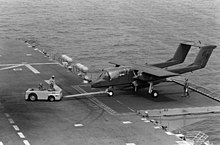
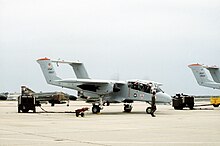

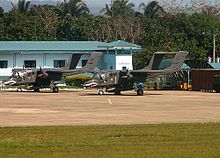

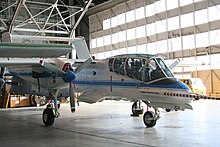
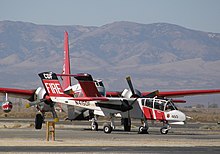



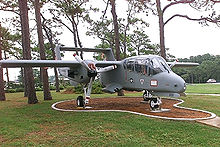

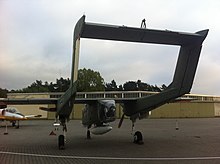
No comments:
Post a Comment